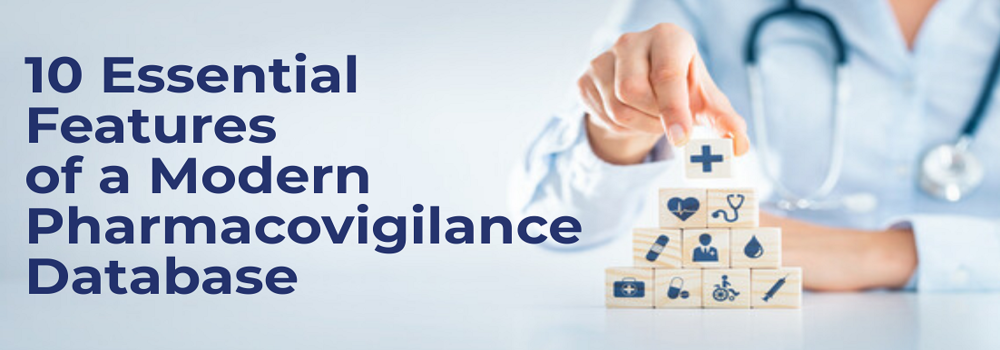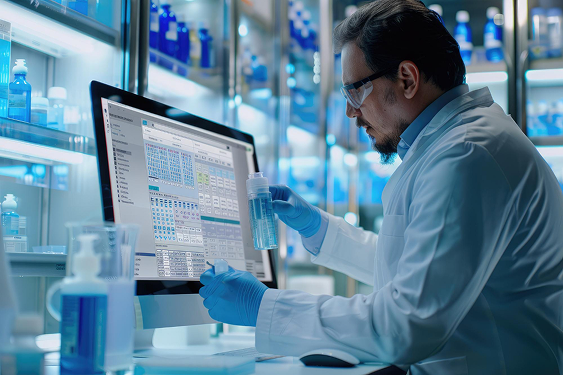10 Essential Features of a Modern Pharmacovigilance Database
Pharmacovigilance has grown significantly in recent years and its importance in the healthcare sector has been recognized worldwide. To prevent or lower the patient hazards, improvements in public health and precise evaluation and monitoring of drug safety has become extremely important. This makes the need for a highly efficient Pharmacovigilance (PV) database essential for all the Pharma, Biotech, and Clinical Research Organizations.
Being a highly essential system in the life sciences sector, a PV database should be able to achieve maximum productivity at the same time keeping track of compliance where the humans can fail to complete the processes with accuracy and efficiency.
To obtain this kind of productivity and efficiency, you must keep in mind some of the essential features which a PV system should comprise.
1. The Must-Have Basic Features:
Below are some essential features that a pharmacovigilance database should have:
- The system should have the ability to report adverse events via configurable web form over secured internet.
- Custom validation should be present to ensure data consistency & completeness of cases.
- ICSRs – R2 & R3 compliance.
- Periodic Reports (like NDA, PADER, PSUR, etc.) and Line listings must be present.
- Must have an automated configuration for listedness.
- Auto narratives.
- Should support medical devices, clinical studies, spontaneous, literature cases, etc.
- MedDRA and WHO Drug dictionary integration
- The system should have more configurations and less customizations
- Must have an in-built AS2 gateway for regulatory e-submissions.
2. User Friendly and Easy-to-Use:
When a company adopts a new technology, sometimes it makes a mistake of neglecting the usability and user friendliness. It is critical to address this for the success of high-performing PV business. This should never be overlooked.

Good usability can improve the performance and result in easy and faster case processing and submissions. It can boost profitability or ROI of your PV business. Training new team members and adopting new processes becomes much easier with the easy to use and user-friendly applications.
A PV database with a lot of advanced features without a user-friendly interface will gradually reduce the performance and the interest of the team and gradually impacts the timelines and the overall business.
3. Configurable to meet sponsor SOPs
The timelines of submission differ for each regulatory agency and sponsors. The SOPs differs from sponsor to sponsor. A PV database should be dynamic enough to be confirmed to address all the changing regulatory and sponsor needs with configurations. The system should not make the sponsor to change his SOP according to the system, but the system should be capable of meeting sponsor SOP and timelines.
Example:
The system should provide dynamic workflows to create different workflows for different types of cases (serious cases vs. non-serious vs. death cases). A company should be able to configure different timelines and different QC/MR process for a serious case and death case.
For a serious case, the admin should be able to set the duration of the complete process as 5 days – set 2 days for the completion of Data Entry, 1 day each for the other three processes, whereas he can set a 15-day duration for a non-serious case and can assign 4 days for Data Entry, 4 days for Quality Review, 4 days for Medical Review, 3 days for Reporting or whatever sequence he requires. Similarly, he can assign the 4 days to the serious and death cases giving 1 day each for every process and so on.
4. Automated Case Tracking / Monitoring Case Submission Timelines
Meeting timelines of the regulatory compliance is a crucial task in Pharmacovigilance. When the number of cases increases, it becomes hard for the CROs/ Pharma companies to track every case to ensure it is processed and submitted to agencies on time.
PV database should be capable of assigning timelines for the cases based on the sponsor / regulatory timelines and track the cases to ensure it is submitted to regulatory agencies on time. The feature should allow the system to give intimation in the form of an automated email to the concerned personnel about the due dates and sends follow-ups if the case has not been dealt with within the required time period.
5. Regulatory Compliance and Inspection Ready
The system should maintain an audit trail for every operation. It should have fully-compliant eSignatures for all stakeholders. Pharmacovigilance database should comply with all current and emerging regulations including 21 CFR Part 11, ANNEX 11, GDPR, GxP, GAMP5 guidelines, etc.

System should comply with global regulations and reports and output formats supported by global regulatory agencies.
The system should also have inbuilt Audit Reports which can be given to auditors during the PV system audits which should give complete audit and necessary information required for easy audits
6. Should be Cost-Effective:
Pharmacovigilance is an expense for any company. Some Pharma/CROs on the verge of saving costs, they cut the costs on the teams they hire, and they spend a lot on procuring traditional Pharmacovigilance databases. This strategy is completely wrong. Just an expensive PV system cannot meet all the regulatory guidelines without a strong team in place.

Pharmacovigilance requires strong quality reviewers, medical reviews and case processers. Pharmacovigilance team is very crucial to any company. Hence companies should spend their PV budget in getting strong and right team in place and focus on reducing the PV budget by choosing a cost-effective PV system.
The technological advancements provide rapid application development options to the software companies who can develop end-to-end PV platform in a short duration and with a small budget. Traditional expensive systems are not really required when a cost-effective Pharmacovigilance database can meet all the regulatory requirements.
7. Website and Call Centre ADRs / MI / PQCs
With the changing regulatory guidelines and increasing regulations, it is important to completely get rid of any information that is tracked out of the Pharmacovigilance databases.
ADRs are generally completely processed and tracked in the Pharmacovigilance database. But most of the PV databases does not support capturing and tracking of the medical inquiries and product quality complaints. Since the MI, PQCs and ADRs goes hand in hand, the Pharmacovigilance database should support handling of MIs and PQCs as well. Pharmacovigilance database should also support receiving the ADRs, MIs and PQCs directly from the Sponsor websites and Sponsor / CRO call centres.
8. AI & Automation

The future is going to be Automation and AI. There are a lot of advancements going on in Pharmacovigilance using Automation and AI. Though there are no solid proven AI capabilities in the PV, the Pharmacovigilance database should have AI and Automation capabilities with which some of the processes like Literature Screening, Social media searches etc. can be automated. The system should be mandatorily built with the framework with supports AI and Automations.
9. Multilingual Capabilities
There is a growing urgent need for accuracy in translation of clinical documentation and reporting; from pre-marketing clinical testing, adverse event / Pharmacovigilance reporting, coding and word-to-word documentation. For some regulators, there is a requirement for the data to be processed and reported in their local language.
For countries like Japan and China, new rules for Pharmacovigilance are on the way. CROs, Biotech and Pharma companies from these countries will soon be required to submit their regulatory reports in their national languages by the end of 2020.
The existing traditional systems can only support English as the language and even if some systems have the capability to provide a setup for any other language such as Chinese, Japanese, etc. or can convert a language into another, they tend to charge a substantial cost for the same.
Multilingual system would also be of great use as the local Pharmacovigilance employs of these countries can complete all the processes efficiently and in little time when provided with an ease of their local language on the PV systems.
Not only in Japan and China, but multilingual PV systems would be extremely beneficial to all the countries in all parts of the world hence the Pharmacovigilance database should be multilingual.
10. Signal Detection
As manual signal detection processes consume considerable time, PV team might require a few weeks to analyse a signal. The system should have an in-built signal detection feature as the PV team require focusing on real-time issues while reducing the time and effort spent in determining the fake signals. Hence it is important that the PV database supports signal detection.




